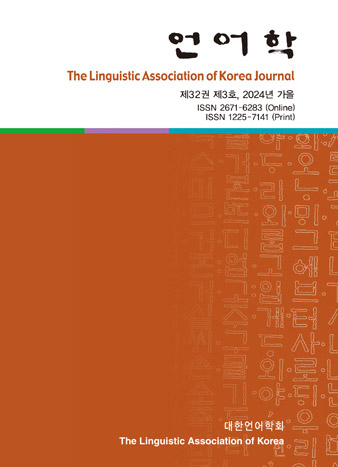대한언어학회 전자저널

-
Machine Translation of Idiomatic Expressions and Slang Based on Korean Drama
-
In Support of the Non-Derivational Analysis of Korean Ditransitive Constructions
-
ChatGPT-integrated English Writing: Writing Strategies and Perceptions
-
On the Differences between American and British English Bible Versions with Reference to get Passive
32권 3호 (2024년 9월)
- In Support of the Non-Derivational Analysis of Korean Ditransitive Constructions
-
Jayeon Park · Hyosik Kim
Pages : 65-84
Abstract
Keywords
# ditransitive # chain condition # quantifier scope # proper binding condition # superiority effect
References
- Baek, J. Y. K., & Lee, J. M. (2004). Double object constructions in Korean: Asymmetry between theme and goal. Language Research, 40(3), 669-679.
- Baker, M. C. (1997). Thematic roles and syntactic structure. In Elements of grammar: Handbook in generative syntax (pp. 73-137). Dordrecht: Springer Netherlands.
- Byma, G. (1986). Scope ambiguity in Hungarian. In Calgary Working Papers in Linguistics, LOGOS.
- Cho, J. H. (1994). Scrambling in Korean: Crossover, reconstruction and bindingtheory. University of Connecticut.
- Cho, J. H. (1994). On scrambling: reconstruction, crossover, and anaphor binding. Theoretical issues in Korean linguistics, 255-274.
- Cho, S. W. (1983). Scope ambiguity and word order in Korean. University of Alberta.
- Choi, K. S. (2005). On the passiveness of doe-da and ji-da. Hangeul 269, 101-134
- Chomsky, N. (1995). The minimalist program. Cambridge, MA: MIT Press.
- Fiengo, R. (1977). On trace theory. Linguistic Inquiry, 8(1), 35-61.
- Fujita, K. (1996). Double Objects, Causatives, and Derivational Economy. Linguistic Inquiry, 27(1), 146–173.
- Johnston, C., & Park. (2001). Some problems with a lowering account of scrambling. Linguistic Inquiry, 32, 727-732.
- Kim, L. (2008). The ditransitive construction in Korean. In Proceedings of conSOLE XV2008 (pp. 111-133).
- Kim, L. (2015). Asymmetric ditransitive constructions: Evidence from Korean. Lingua, 165, 28-69.
- Ko, H. (2018). Scrambling in Korean syntax. In Oxford Research Encyclopedia of Linguistics.
- Larson, R. K. (1988). On the double object construction. Linguistic Inquiry, 19(3), 335-391.
- Lee, Y. S. (1994). Scrambling as case-driven movement. Studies in Generative Grammar, 4(2), 495-533.
- Mahajan, K. (1990). The A/A-Bar Distinction and Movement Theory, PhD dissertation, MIT.
- Matsuoka, M. (2003). Two Types of Ditransitive Constructions in Japanese. Journal of East Asian Linguistics, 12(2), 171-203.
- Miyagawa, S. (1997). Against optional scrambling. Linguistic Inquiry, 1-25.
- Myeong. J. H. (2023). The study of syntagmatic order of auxiliary verb constructions in Korean. Korean Journal of Linguistics, 48(3), 713-730.
- Rizzi, L. (1986). On chain formation. In The syntax of pronominal clitics (pp. 65-95).
- Saito, M. (1985). Some asymmetries in Japanese and their theoretical implications (Doctoral dissertation, NA Cambridge).
- Saito, M. (1992). Long distance scrambling in Japanese. Journal of East Asian Linguistics, 1, 69-118.
- Shim, J. Y. (2010). Long-Distance Superiority andthe Dependency of Arguments. The realization of L*+ H pitch accent in Greek, 174.
- Takahashi, D. (1993). Movement of WH-phrases in Japanese. Natural Language & Linguistic Theory, 11(4), 655–678